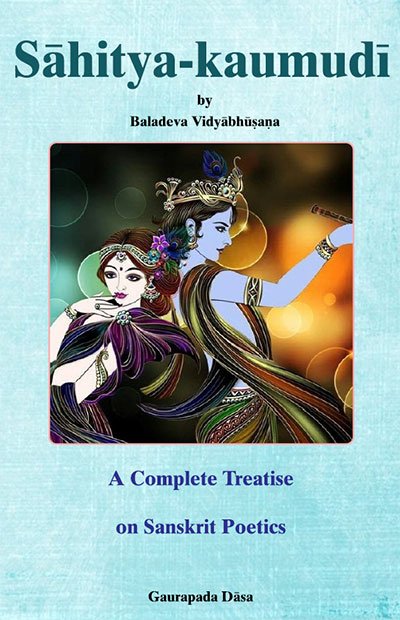Sahitya-kaumudi by Baladeva Vidyabhushana
by Gaurapada Dāsa | 2015 | 234,703 words
Baladeva Vidyabhusana’s Sahitya-kaumudi covers all aspects of poetical theory except the topic of dramaturgy. All the definitions of poetical concepts are taken from Mammata’s Kavya-prakasha, the most authoritative work on Sanskrit poetical rhetoric. Baladeva Vidyabhushana added the eleventh chapter, where he expounds additional ornaments from Visv...
Text 10.67
उदाहरणम्,
क्वहं दैन्य-भराक्रान्तः क्वयं श्री-पतिर् अच्युतः ।
तृषार्तम् उपसंयातो निपातः सौर-सैन्धवः ॥
udāharaṇam,
kvahaṃ dainya-bharākrāntaḥ kvayaṃ śrī-patir acyutaḥ |
tṛṣārtam upasaṃyāto nipātaḥ saura-saindhavaḥ ||
kva—where?; aham—am I; dainya—of a miserable state; bhara—by the weight; ākrāntaḥ—overcome; kva—where?; ayam—He; śrī-patiḥ—Lakṣmī’s husband; acyutaḥ—Acyuta; tṛṣā—by thirst; ārtam—[someone] pained; upasaṃyātaḥ—has approached; nipātaḥ—the fall (the flow); saura-saindhavaḥ—related to the Ganges (sura-sindhu).
Where am I? I am overcome by a burden of affliction. And where is Acyuta? He is Lakṣmī’s husband. The flow of the Ganges has approached someone pained by thirst.
atra tṛṣṇākulasya gaṅgā-saṅgama iva dīnasya me śrī-kānta-sākṣātkāra ity upamā kalpyate.
Here this simile is imagined: “Being afflicted, my directly seeing Lakṣmī’s husband is like a parched individual’s contacting the Ganges.”
Commentary:
This is Mammaṭa’s example:
kva sūrya-prabhavo vaṃśaḥ kva cālpa-viṣayo matiḥ |
titīrṣur dustaraṃ mohād uḍupenāsmi sāgaram ||“Where on one hand is the solar dynasty and where on the other is my intellect of little scope? Out of folly, I want to traverse the hard-to-cross ocean with a raft.” (Raghu-vaṃśa 1.2)
Mammaṭa elaborates: atra, uḍupena sāgara-taraṇam iva man-matyā sūrya-vaṃśa-varṇanam ity upamāyāṃ paryavasyati, “Here the statement culminates in a simile: “Describing the solar dynasty by means of my intellect is like crossing the ocean with a raft”” (Kāvya-prakāśa, verse 435 vṛtti).
However, in each verse, if there is no follow-up that implies a simile, that huge contrast by itself is classed as the first variety of the viṣama ornament (disparity) (10.203-204).
Nāgeśa Bhaṭṭa makes two categories of nidarśanā: śābdī (understood from the words) and ārthī (understood from the sense). He says Mammaṭa’s example illustrates the latter. He exemplifies the former: “One who colors the jewels of your nails with red nail-polish makes the moon whitish with off-white sandalwood paste.”[1]
Footnotes and references:
[1]:
